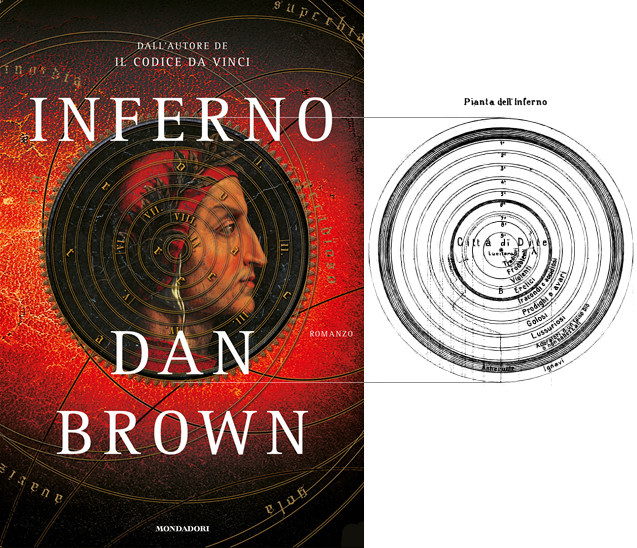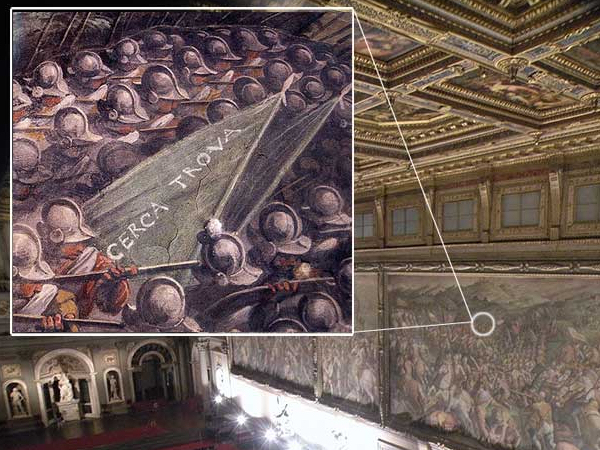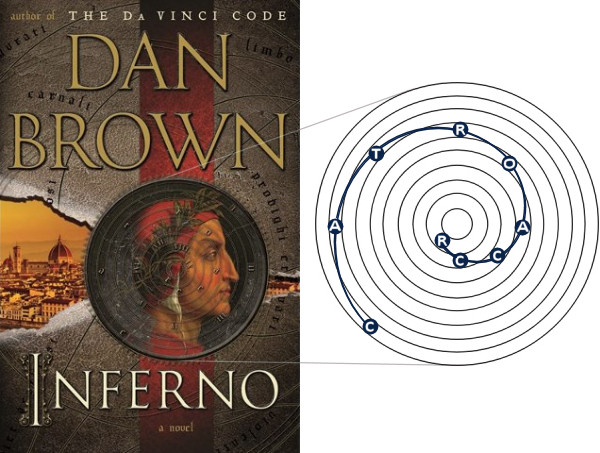Inferno, the new thriller by Dan Brown, will be released around the world on May 14. The date has not been chosen at random: it is written 5-14-13, which read backwards 3.1415 – the value of pi.
The plot has been inspired by Dante Alighieri and his 14th-century epic poem The Divine Comedy, interpreted as a “coded” work on the trail of an umpteenth, explosive secret. The first hints are already available to the readers on the cover of the novel.
The Italian edition of the book shows, at the very center, a representation of the Hell and its nine concentric circles, each circle representing a specific sin – taken from a well known book by Manfredi Porena (1902): (1)

Comparison between the cover of the novel and the representation by Manfredi Porena (1902)
Inside the nine concentric circles ten letters have been arranged along a spiral, which form the sequence CATROVACER:

The meaning of the string has been recently revealed by Mauro Ballesio, who wrote me:
The sequence must be written on a circle and cut so as to form the two words “CERCA TROVA” (“SEEK FIND”): it is the enigmatic writing which Giorgio Vasari (1511-1574) inscribed in his fresco in the Sala dei Cinquecento in Palazzo Vecchio (Florence), painted probably on an earlier work by Leonardo Da Vinci. The writing has ignited the imagination of treasure hunters, according to whom it refers to a lost work of Leonardo – “The Battle of Anghiari”. Some have even suggested that the fresco hides a secret cavity in which the work is still hidden. (2)

The writing “CERCA TROVA” on the fresco by Vasari.
Ballesio notes that the words are evoked in the first chapter of Dan Brown’s novel, where Robert Langdon comes across a strange veiled woman who whispers:
Time grows short. Seek and find. (3)
We do not know the relevance of this coded message in the novel, but a further clue comes from the American cover, where the sequence CATROACCR appears on the nine concentric circles:

The topic has been discussed a few days ago on Greg Taylor’s blog The Cryptex, where on March 11 a mysterious UDbmas wrote:
CATROACCR = TESORETTO
Mauro Ballesio has checked 245000 distinct Italian words, finding that TESORETTO is the only one that allows a transliteration of CATROACCR. Since the logical rule to change from CATROACCR to TESORETTO is not clear, it has been hypothesized that UDbmas is actually a nickname used by Dan Brown to unveil a (otherwise impossible to decode) clue.
Even the word “Tesoretto” refers to Palazzo Vecchio, being the name of a small secret room, whose existence was forgotten until 1908, when it was rediscovered during restoration work.
The room was built under the reign of Cosimo I de’ Medici (1519-1574) for storing jewels, documents and personal objects of scientific interest. It had no windows, it was decorated by Vasari with strictly secular images and was off limits even to members of servitude.
By connecting all the dots, Ballesio raises this interesting hypothesis:
If TESORETTO is the correct transliteration of CATROACCR, I assume that Dan Brown has suggested – in the fiction of the novel – that the lost work of Leonardo is in the secret closet of Cosimo I de’ Medici.
So let’s follow the veiled woman advice. Let’s seek... and we will find!
2. Mauro Ballesio, personal communication (April 2, 2013).
BY-NC-SA 4.0 • Attribution-NonCommercial-ShareAlike 4.0 International